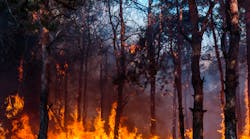Cal/OSHA is reminding employers about the need for the proper protection and personal protective equipment as wildfires rage across the state.
Smoke from wildfires contains chemicals, gases, and fine particles that can harm health. The greatest hazard comes from breathing fine particles, which can reduce lung function, worsen asthma and other existing heart and lung conditions, and cause coughing, wheezing and difficulty breathing, according to Cal/OSHA.
Guidance for employers and workers on working safely in conditions with heavy smoke caused by the wildfires is available on Cal/OSHA’s web page, including frequently asked questions about N95 masks for employers and workers.
Employers with operations exposed to wildfire smoke must consider taking appropriate measures as part of their Injury and Illness Prevention Program under Title 8 section 3203 of the California Code of Regulations and as required under section 5141 (Control of Harmful Exposure to Employees). Those measures include:
- Engineering controls whenever feasible (for example, using a filtered ventilation system in indoor work areas)
- Administrative controls if practicable (for example, limiting the time that employees work outdoors)
- Providing workers with respiratory protective equipment, such as disposable filtering facepieces (dust masks).
- To filter out fine particles, respirators must be labeled N-95, N-99, N-100, R-95, P-95, P-99 or P-100, and must be labeled approved by the US National Institute for Occupational Safety and Health (NIOSH).
- Approved respiratory protective equipment is necessary for employees working in outdoor locations designated by local air quality management districts as “Unhealthy”, “Very Unhealthy” or “Hazardous”.
It takes more effort to breathe through a respirator and it can increase the risk of heat stress. Frequent breaks are advised. Workers feeling dizzy, faint or nauseated are advised to go to a clean area, remove the respirator and seek medical attention.
Respirators should be discarded if they become difficult to breathe through or if the inside becomes dirty. A new respirator should be used each day.
